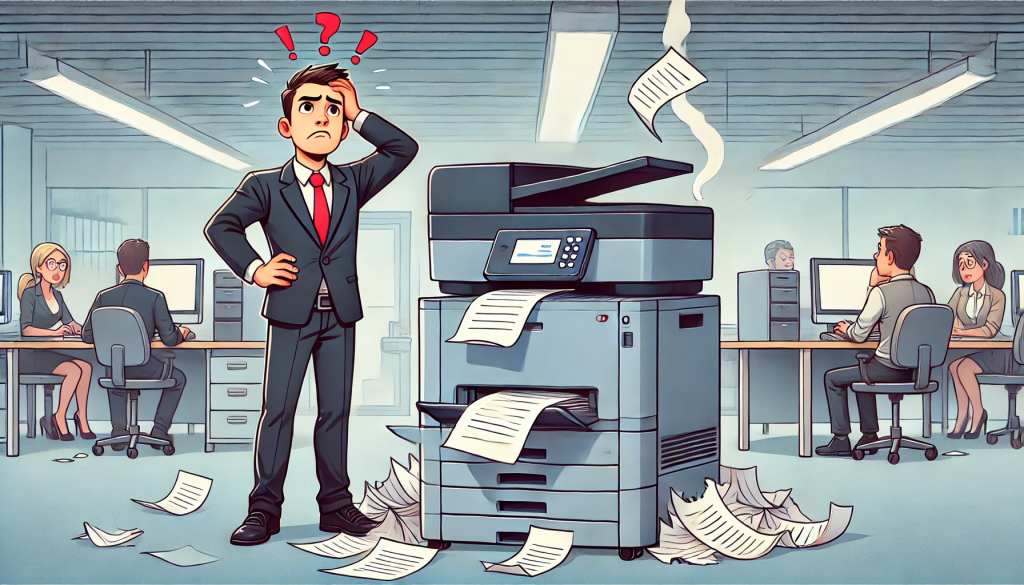
Introduction
We’ve all been there. You’re racing against the clock, an important document needs to be printed for a crucial meeting, and then it happens—the dreaded paper jam. You watch in frustration as the printer beeps and flashes, bringing your productivity to a screeching halt.
Paper jams are an all-too-common issue in offices and homes. Understanding the causes and knowing how to quickly resolve them can save you time and headaches.
This article will explore why paper jams happen, provide step-by-step instructions on how to fix a paper jam, and offer tips on preventing paper jams in printers.
Section 1: Why Does My Printer Keep Jamming?
Common Paper Jam Causes
- Misaligned Paper: If the paper isn’t properly aligned in the tray, it can easily cause a jam. Misalignment disrupts the smooth flow of paper through the printer.
- Overfilled Paper Tray: Overloading the paper tray can result in multiple sheets being fed into the printer simultaneously, leading to jams.
- Incorrect Paper Type: Using paper that is too thick, too thin, or wrinkled can cause jams. Printers are designed to handle specific paper types and weights.
- Debris or Foreign Objects: Small bits of paper, dust, or other debris can obstruct the paper path.
- Worn Out Printer Parts: Over time, parts like rollers and gears can wear out, increasing the likelihood of jams.
Less Common Causes
- Humidity Issues: High humidity can cause paper to absorb moisture, making it stickier and more likely to jam.
- Software Glitches: Occasionally, software errors or outdated drivers can cause the printer to misfeed paper.
Section 2: How to Fix a Paper Jam (Step-by-Step Guide)
Emphasize Safety
Before attempting to clear a paper jam, always turn off and unplug the printer. This ensures your safety and prevents damage to the printer.
General Steps
- Locate the Jammed Paper: Check all paper trays, output areas, and internal pathways for any jammed paper.
- Gently Remove the Paper: Pull the paper in the direction of the paper path to avoid tearing it. If it is torn, carefully remove all fragments.
- Check for and Remove Debris: Ensure there are no bits of paper or other debris left in the printer.
- Reload the Paper Correctly: Align the paper properly in the tray, making sure it’s not overfilled.
- Restart the Printer: Turn the printer back on and try printing again.
Tips for Specific Common Paper Jam Problems
- Multiple Sheets Jammed: Remove one sheet at a time, being careful not to tear them.
- Jammed Paper Not Visible: Consult your printer’s manual for specific instructions on locating hidden jams.
- Jammed Paper in Duplexer: Follow the printer’s instructions for clearing a jam in the duplexer (the part that handles double-sided printing).
Section 3: Troubleshooting Printer Paper Jam
Address Paper Jam Error Messages
Printers often display error messages or codes when a jam occurs. Here are some common codes and their meanings:
- E03: Indicates a paper jam.
- E04: Suggests an issue with the paper feed.
- E05: Points to a problem with the paper path.
Tips for When a Paper Jam Won’t Clear
- Try Different Paper Types: If your paper is too thick or thin, switch to a type recommended by your printer’s manufacturer.
- Clean the Printer’s Rollers: Dirty rollers can cause jams. Use a lint-free cloth dampened with water to gently clean them.
- Seek Professional Help: If all else fails, it might be time to call a printer repair technician.
Section 4: Preventative Measures: How to Avoid Paper Jams
DIY Paper Jam Repair and Maintenance
- Regularly Clean Your Printer: Remove dust and debris from the paper trays and internal components.
- Use High-Quality Paper: Ensure the paper is compatible with your printer.
- Don’t Overfill the Paper Tray: Leave some space in the tray to allow for smooth paper feed.
- Fan Paper Before Loading It: This helps prevent static cling, which can cause multiple sheets to stick together.
- Store Paper in a Cool, Dry Place: Avoid storing paper in humid areas to prevent moisture absorption.
Conclusion
Paper jams are frustrating, but understanding their causes and knowing how to fix them can make your printing experience much smoother. By following the steps outlined above and implementing preventative measures, you can minimize the occurrence of paper jams.
